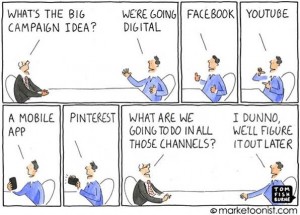I’ve spent my entire 20+year career helping B2B technology brands “market” themselves better. And one thing I’ve discovered is this: most companies don’t have any idea who they’re talking to.
Don’t worry; it’s not just your brand; it’s a universal challenge. Size of the company doesn’t seem to matter, nor does the volume of PR and marketing investment, or the passion of its employees. Most B2B technology brands simply don’t have a solid understanding of their target audience and what motivates buyers to write a check.
When asked, these same companies will insist they know their audience. At least, they have a gut feeling from all the years of experience so that should be good enough, right? Wrong.
Not understanding the behaviors, motivators and influencers of buyers is one of the top reasons why companies waste marketing budget, spin wheels and feel like the “market just doesn’t get us.” It can also frustrate the sales team, confuse the market and empower the competition.
So, do you know who you’re talking to? Here are three of the most obvious signs that you don’t (and how you can take a step back, get some audience insights and rebuild your marketing program):
1. Management and/or marketing keep changing the message.
A key sign that there’s more to learn about your audience is the revolving door of messaging. If you have a mission, vision, purpose, elevator story, message set, points of differentiation, company description, boilerplate, brochure, website, Twitter handle and tagline that all tell a different story – you’ve got a problem.
Most companies get tangled up in their own language and lingo – but that’s the kicker – your story shouldn’t be designed to tell people what you do or even how you do it. It should help people understand why you do what you do, and how it’s relevant to them as a buyer. The more you know about your buyer’s motivations, the easier this is to do.
So, tap into the source. By actually talking to your customers and prospects (instead of relying on gut feeling) you can create a definitive persona of your buyer and use this to laser-focus your messages and marketing efforts.
For example, we recently kicked off an annual Customer Advisory Council for a B2B technology brand and regularly conduct “Voice of the Customer” research via surveys and interviews. This type of insight helps create personas that inform the messaging so that everyone can tell the same story.
2. You think, “we just need to get in the New York Times, Wall Street Journal, Forbes [insert any major daily news source here], and then everyone will know who we are.”
Sorry, Charlie, national business media is not your golden ticket. In fact, you’re wasting a whole lot of time, effort and money trying to land coverage here for your B2B brand. Sure, some dazzling, highly-funded B2B brands get in the New York Times but that usually means being in the right place, at the right time.
Think about it this way: The guy that needs a new, real-time software platform to make sure that the production line is in synch with supply chain partners isn’t looking for ideas in the Wall Street Journal. He’s talking to peers, asking the industry analysts, reading trade media that offers insights into trends and probably searching online, using a network and resources he trusts.
So, before you task your PR team with landing the New York Times, ask yourself a few questions: Is this the most direct way I can reach my prospects? If I was looking for the best XYZ product, where would I look? Have I asked my prospects how they make these decisions?
If you’ve done your audience homework (or had us do it for you), you’ll have most of the answers you need. And you can focus on tactics that reach your buyer more directly, in a targeted manner. This may lead you to direct marketing, retargeting, more phone outreach, custom events or other activities that are one-to-one.
3. Your communications programs consist of a lot of tactics, but no strategy.
When you don’t understand your audience, it’s common to try a lot of different tactics. But this makes it hard to measure what’s working and what isn’t. Plus, it’s usually a big budget burner.
Your prospect’s buying decision happens in a linear manner (remember, awareness to adoption) – so it makes sense that communications to spur a purchase or overcome barriers to purchase happen along the same linear path.
If you’re not sure why you’re communicating using specific tactics, such as press releases, social media, or direct mail, and your desired results of each tactic then you haven’t done the work to understand your audience and how they want you to communicate. And, you haven’t matched your tactic to the audience based on where they are in the buyer’s journey.
No marketing manager wants to go to the management team and tell them to stop marketing. But staying the course and getting mediocre results isn’t an option either. Sometimes, you have to take a step back and examine the landscape. With audience insights, your marketing strategy is informed, which leads to a better plan for messaging and, ultimately, tactics. Don’t be afraid to research and rebuild. You’ll be amazed at how much more you can accomplish.


